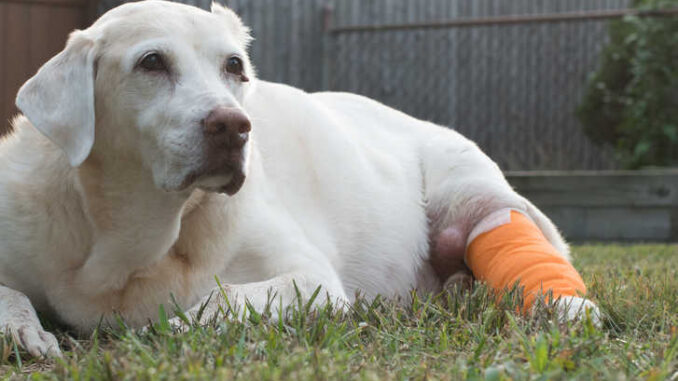
In a healthy body, mast cells are specialized white blood cells found throughout the body that play a crucial role in allergic response. A mast cell tumor is a mass made up of an overabundance of mast cells. These typically occur as bumps or nodules on the skin but can form in other body parts.
Unfortunately, mast cell tumors are one of the most common malignant skin cancers in dogs, accounting for up to 20% of all skin cancers in dogs.
If your dog has already been diagnosed with a mast cell tumor, your veterinarian will want to determine the tumor’s grade and staging. What does this mean, and how will it affect your dog’s treatment?
Grading is usually done by a pathologist when reviewing cell samples on slides. It is the description of the tumor on a microscopic level. Grading helps determine the extent of the tumor and whether it is likely to remain local (in the immediately surrounding tissue) or metastasize (spread throughout the body).
Staging can be done by your veterinarian using testing and imaging such as ultrasound and xrays. Staging is the extent the tumor has spread to other parts of the body or metastasized.
Once your veterinarian has determined the grade and stage of the mast cell tumor, they will be better able to put together a treatment plan and give a prognosis for your dog’s specific case.
What is a Stage 1 Mast Cell Tumor?
Mast cell tumors occur in four stages. The cancer stage is determined by how much the tumor has spread (or metastasized) to other parts of your dog’s body.
Stage I – A single tumor that has not metastasized
Stage II – A single tumor that has metastasized to nearby lymph nodes
Stage III – One or more skin masses that have involved subcutaneous tissues, with or without lymph node involvement
Stage IV – One or more tumors that have metastasized to lymph nodes and other organs
So Stage 1 means your dog has a mast cell tumor, typically on the skin, but it has not spread or affected lymph nodes or other parts of the body.
To determine the stage of the tumor, your veterinarian will collect cell samples from the lymph nodes near the tumor using a process called fine needle aspiration. Similarly to how they likely diagnosed the mast cell tumor in the first place, vets direct a small needle into the lymph node to collect cells and place them on a microscope slide. These slides are then sent to the pathologist for further evaluation.
Chest radiographs may be recommended to assess spread to the lungs, although mast cell tumors are less likely to spread to the lungs than to abdominal organs. Ultrasound of the abdomen may show spread to other organs like the liver, spleen, and abdominal lymph nodes.
By determining the stage of the tumor (how much it has spread), your veterinarian will decide the type of treatment that is best for your dog.
What does a stage 1 tumor look like?
Mast cell tumors are known as the “great pretenders,” meaning they can look like various masses. Your dog may have a small or large lump. It could be hard or soft and a range of colors. It can be smooth or ulcerated. There is no simple way to describe the appearance of most mast cells.
One unique characteristic of mast cells that often doesn’t happen with other types of tumors is variation in size. The lump could appear out of nowhere, or it could even shrink and grow daily. This often has to do with the somewhat random release of histamine from the mast cells.
What about Grading in Mast Cell Tumors?
Grading describes the mast cell tumor on a microscopic level and is one of the most critical indicators for prognosis and guiding treatment. Grading aims to predict how aggressive the cancer is and whether it will likely metastasize.
Grade I – well differentiated, relatively normal-looking mast cells; a low metastatic rate
Grade II – most common grade seen in MCTs. Determining if the mass will metastasize or act more like grade I can be tricky. It likely will require more testing and monitoring.
Grade III – poorly differentiated and have a high metastatic rate; very poor prognosis
What is the life expectancy of a dog with a grade 1 mast cell tumor?
Grade 1 and 2 tumors are the easiest to treat, but prognosis will depend on multiple factors, including tumor size, location, ability to completely remove, and symptoms. Most dogs with lower-grade tumors will fully recover with no tumor regrowth after surgery. Many of these dogs only require follow-up exams to ensure no new tumors are growing.
Complete removal of all the cancer cells is the goal of surgical excision. If all the cancer cells are removed during the surgery, “90-100% of the time, the tumors do not return.” According to a veterinary article, “The prognosis for even incompletely removed grade 1 or 2 tumors treated with radiation after surgery is excellent, with 90-95% of dogs having no reoccurrence of the tumor within three years of receiving radiation therapy.”
Treatment for a Low-Grade Mast Cell Tumor
Dogs with low-grade, stage 1-2 tumors are usually treated with:
- Surgery
- Antihistamines
- Steroids
- Antacids
The treatment option for Grade 1 tumors is surgical removal. The veterinary surgeon will remove large margins (around 2-3 cm) of healthy skin around the tumor. This will ensure most of the cancer cells are removed. The tissue removed during the surgery will be sent to a pathologist and microscopically examined.
You may hear your veterinarian talk about margins and the ability to close the skin. Complete removal with “clean margins” (meaning no tumor left behind) is especially important when the tumor is in a location that may be more difficult to completely remove, like a leg. Since there is less skin on the extremities, it is harder to remove 2 centimeters of healthy surrounding tissue with the mass and still be able to close the skin.
This is important for veterinarians and owners to consider when agreeing on a treatment plan for a mast cell tumor. Ideally, surgery is used in low-grade tumors to completely remove cancer cells, but that is not always that straightforward. If the veterinarian cannot remove all cancerous cells, there is a risk that the mast cell tumor could regrow in the same spot.
What medication will my dog need?
Mast cells are full of histamine granules involved in normal allergic responses. When mast cell tumors degranulate or release lots of histamines, they can cause a range of symptoms in your dog, from itchiness to life-threatening anaphylaxis. Unfortunately, even gentle handling of MCTs can lead to this massive histamine release.
One medication used to manage MCT symptoms is an antihistamine like Benadryl. Prednisone is a steroid that can also help decrease inflammation and itching. Antacids are used to soothe the stomach and reduce the nausea caused by irritation in the stomach.
Typically low-grade MCTs do not need chemotherapy, unlike high-grade and stage III/IV MCTs, which carry a poorer prognosis.
What is the cost of treating a stage 1 dog?
Costs may vary widely based on these factors:
- Exam fees – remember your dog will need frequent monitoring to look for other masses
- Cost of fine needle aspirate of the mass and lymph nodes
- Surgery and any additional surgeries if the mass was not completely removed – typically, surgery costs for mass removals range from $800-$2000, depending on location, size, and the number of masses removed.
Is there anything else that dog owners should know?
It is best to have all new lumps and bumps tested on your dog immediately. Most of the time, your veterinarian cannot diagnose a mass just by looking at it and will be unable to tell you if it is malignant or benign without sending cell samples to the lab or looking at them under the microscope.
Even if a mass turns out to be benign, removal while the mass is small is recommended. Waiting until a mass has grown large can also make removal more challenging and with more healing complications.
Disclaimer: This website's content is not a substitute for veterinary care. Always consult with your veterinarian for healthcare decisions. Read More.


Be the first to comment